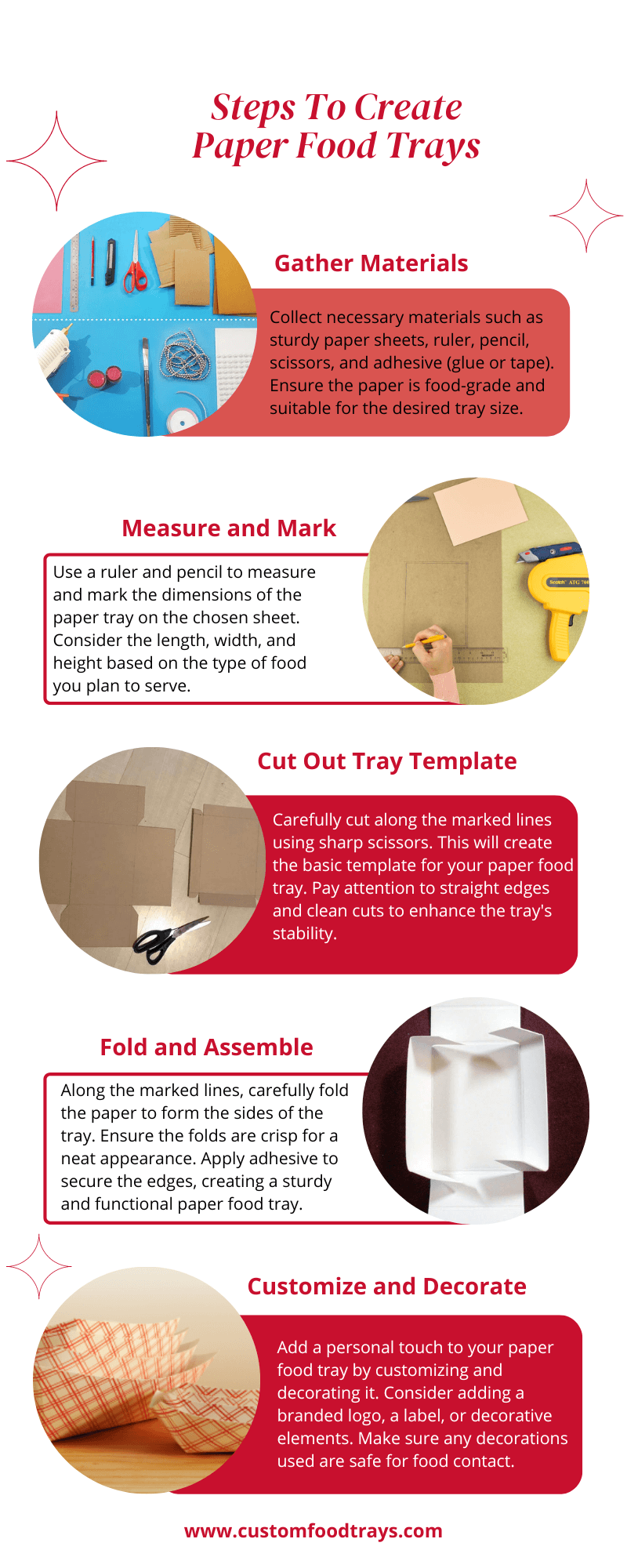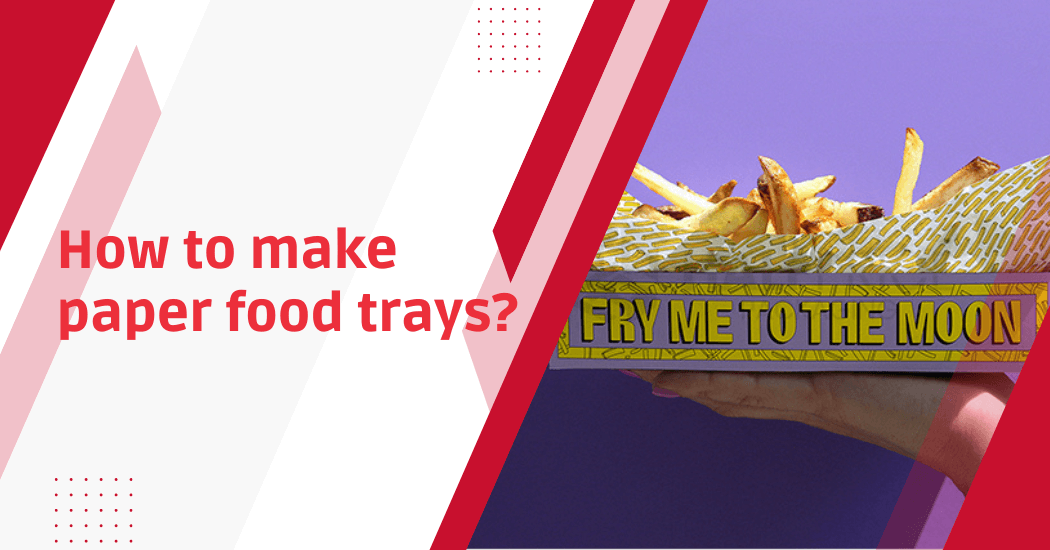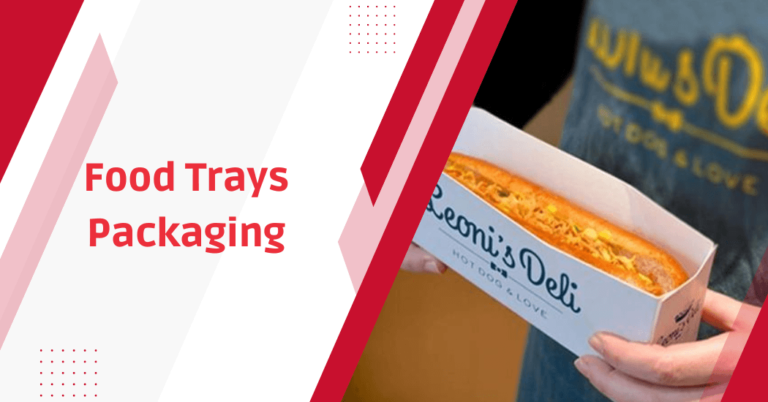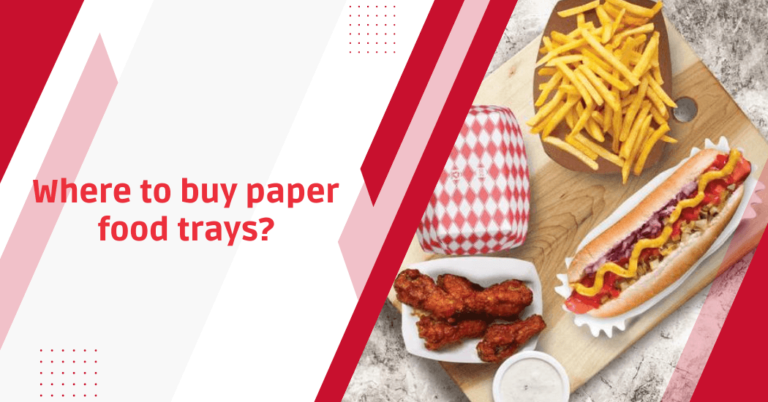How to make paper food trays?
Paper food trays are versatile and eco-friendly alternatives to plastic and Styrofoam containers, widely used for serving a variety of culinary delights. These trays are not only convenient for packaging takeout or street food but also contribute to a more sustainable and environmentally responsible approach to food service.
Crafting your paper food trays can be a creative and cost-effective way to personalize your serving solutions, reduce your environmental footprint and add a unique touch to your culinary creations.
In this blog post, we will explore the step by step process of making paper food trays, providing you with the knowledge and skills to create these handy containers for your food service needs or DIY projects.
Make your own paper food trays!
List of required supplies to create paper food trays
- Cardstock paper: Choose sturdy and food-safe cardstock paper as the main material for your trays. The thickness of the paper should be substantial enough to hold food without tearing or leaking.
- Scissors: Sharp scissors are needed to cut out the tray template from the cardstock paper.
- Ruler: A ruler will assist in measuring and drawing precise lines for accurate folding.
- Pencil: Use a pencil to trace out the tray template onto the cardstock before cutting it out.
- Glue: Non-toxic craft glue is used to secure and hold the tray’s shape together. Ensure the glue is safe from incidental food contact.
- Bone folder: This tool, though optional, is handy for creasing the paper, which helps in folding and maintaining the tray’s shape.
- Tray template: You can find printable tray templates online that suit your specific serving needs. Print these on plain paper and use them as a guide to cut your cardstock.
Instructions to prepare for crafting paper food trays
Before beginning the process of making paper food trays, here are a few essential steps to prepare for crafting:
- Choose your template: As mentioned earlier, you can find many printable tray templates online, or you can create one yourself using plain paper or cardboard.
- Select your cardstock: Consider the type and weight of cardstock that will suit your serving purpose. For example, if you’re serving hot or greasy food, choose a cardstock with a wax coating to prevent any leakage.
- Gather your supplies: Make sure you have all the necessary supplies mentioned above within reach before starting the crafting process.
- Set up your workspace: Choose a clean and flat surface to work on, preferably covered with a protective layer like a plastic sheet or newspaper to avoid any mess.
- Prepare the template: Print out your chosen tray template on plain paper and cut it out carefully using scissors.
Steps to create paper food trays
- Choose the size and shape: Decide on the size and shape of your tray depending on the type of food you plan to serve. You can opt for a rectangular, triangular or circular tray, with dimensions that fit your serving needs.
- Prepare the template: Use a pencil and ruler to trace the template onto your cardstock paper and cut it out using scissors.
- Score the lines: Using a ruler and bone folder, score along the fold lines on the template to make folding easier.
- Fold along scored lines: Carefully fold along the scored lines on the cardstock to create the tray’s sides and base.
- Glue edges together: Apply a thin layer of non-toxic craft glue along the edges to secure the sides and base in place.
- Hold in place: Use clothespins or paper clips to hold the glued edges together until the glue dries completely.
- Optional step – add handles: If you want to make your tray more convenient to carry, you can create handles on each side by cutting out small rectangular shapes and gluing them to the tray’s edges.
- Allow to dry: Let the tray dry completely before using it for serving food.

Tips for crafting paper food trays
| Tip | Explanation |
|---|---|
| Choosing the right cardstock | The type and weight of the cardstock can significantly impact the sturdiness and integrity of your paper food tray. Ensure you choose a cardstock that is sturdy, food-safe, and suitable for the type of food you plan to serve. |
| Scoring the fold lines | Scoring the fold lines before folding can make the folding process significantly easier and more accurate. It also helps in maintaining the tray’s shape. |
| Usage of non-toxic craft glue | Always ensure to use non-toxic craft glue that is safe for incidental food contact. This ensures the safety and hygiene of the food served in the trays. |
| Securing the glued edges | Using clothespins or paper clips to hold the glued edges together until the glue dries completely can prevent the tray from unfolding or losing its shape. |
| Adding handles | Adding handles to the tray not only makes it more convenient to carry but also adds an aesthetic appeal. Ensure the handles are securely glued and can withstand the weight of the food. |
| Allowing tray to dry | Letting the tray dry completely before serving food ensures the glue is completely dried and the tray is sturdy and ready for use. |
| Experimenting with unique templates | Have fun trying out different tray templates and shapes to add a personal touch to your dining experience. You can even create themed trays for special occasions or events. |
FAQs – Paper Trays Making
What is the best type of paper for food trays?
For food trays, it is best to use sturdy and food-safe cardstock paper. The thickness of the paper should be substantial enough to hold food without tearing or leaking.
Can I make a tray of any shape and size?
Yes, you can decide on the size and shape of your tray depending on the type of food you plan to serve. You can opt for a rectangular, triangular, or circular tray with dimensions that fit your serving needs.
What should I do if the glue does not dry quickly?
You can use clothespins or paper clips to hold the glued edges together until the glue dries completely. This will prevent the tray from unfolding or losing its shape.
How can I add a personal touch to my paper food trays?
You can experiment with unique templates, add handles, or create themed trays for special occasions or events. You can also use decorative paper or paint to add a personal touch to your trays.
Are paper food trays reusable?
Paper food trays are not designed for multiple uses and may become weak or damaged after one use.
However, you can reuse them for light-duty tasks such as holding small items or storing craft supplies. Overall, it is best to make new trays for each use to ensure food safety and hygiene.
How do I dispose of paper food trays?
Paper food trays can be easily disposed of in the recycling bin, as long as they are clean and free from any food residue. You can also compost them if they are made from biodegradable materials.
However, if the tray has come into contact with greasy or oily foods, it is best to dispose of them in the regular trash. Always check with your local recycling guidelines for proper disposal methods.
Wrap Up
Creating your paper food trays is a fun, cost-effective, and environmentally friendly way to serve food at your gatherings or events. With a bit of creativity and a few materials, you can design trays that reflect your style and cater to your serving needs.
Remember to select a sturdy, food-safe cardstock, score your fold lines for ease and accuracy, and use non-toxic glue to secure your trays.
While these trays are not intended for multiple uses, they offer a unique and personal touch to your dining experience. Lastly, dispose of your paper food trays responsibly, following local recycling guidelines.






